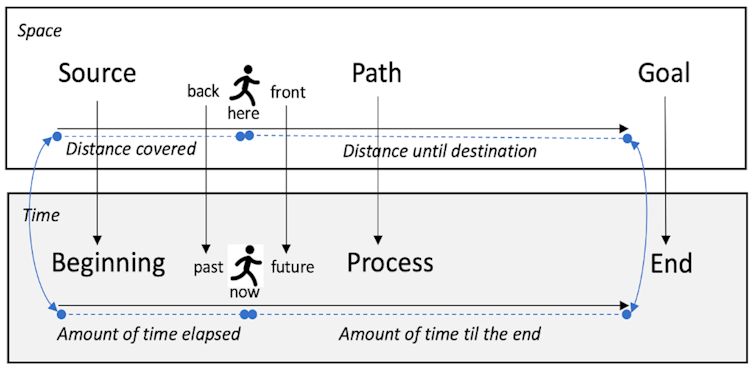Expressions linking space to time are a common part of our day to day lives. You might say the morning “flew by”, or that school exams are “fast approaching”. Right now, you might say summer is “just around the corner”, while anyone with the vaguest awareness of Game of Thrones will have heard the phrase “winter is coming”.
Unlike the physical space we inhabit, time cannot be seen or touched, though it structures every moment of our waking lives.
How, then, did humans come to talk so effortlessly about such a nebulous, abstract concept? The key lies in the way we project our understanding of space – the tangible dimensions we can interact with – to conceptualise time.
Understanding the world through metaphor
Explorations of how humans conceptualise time as space are tied closely to the study of language and cognition. Conceptual Metaphor Theory, developed by George Lakoff and Mark Johnson, proposes that our conception of the world is governed by metaphors, many of them anchored in the three dimensions of physical space.
Metaphors play an essential role in human reasoning, influencing how we talk about and comprehend abstract ideas. We use our awareness of space and movement as a domain in which we can better understand more complex concepts such as time.
Therefore, when we say a meeting is being “moved forwards”, we visualise time as an element that moves, and in which we move, reflecting our tendency to interpret abstract ideas through physical experience.
Different cultures, different understandings of time
The idea of linguistic relativity, originally put forward by Benjamin Whorf and Edward Sapir, suggests that the language we speak determines how we interpret the world around us.
Studies have shown that different cultures and languages do not all perceive time in the same way. In English, for example, we talk about future events as being in front of us – one might say we “have a bright future ahead” – while the past is, as per the popular expression, behind us.
Majid Rangraz / Unsplash
However, the Aymara, an indigenous people of South America, see things the other war round. They place the past ahead, as it is already seen and therefore known, while the future is behind, because it cannot be seen, and is yet to be known.
In other languages, such as Mandarin Chinese, time is visualised as a vertical axis: events in the past are “above” while events in the past are “beneath”. “Last month” (上个月–) therefore translates literally as “the month above”.
In many Western cultures, where text runs from left to right, there is a natural tendency to associate leftward movement with the past, and rightward movement with the future. This is not only reflected on paper – when drawing historical timelines, for example – but also in the gestures we make when speaking about past or future events: speakers of languages read from left to right tend to gesture to the left when talking about the past, and to the right when talking about the future.
However, this is far from universal. In cultures that write from right to left, such as in Arabic or Hebrew, such gestures are often inverted: while a Spanish or English speaker would gesture to the left to talk about the past, an Arabic or Hebrew speaker would point to the right.
Two perspectives on navigating time
Metaphors of time can be divided into “ego moving” and “time moving”, and this distinction illustrates the different ways of perceiving the relationship between space and time. In “ego moving” metaphors, a person moves towards a fixed point in time, for example, “we’re getting close to summer”. In “time moving” metaphors, time instead moves towards the individual – “Summer is nearly here”.

Created by Illán Castillo, taken from Valenzuela & Illán Castillo (2022).
A number of factors influence whether we use one type of metaphor or another. These include language structure, cultural perspectives towards an action or destination, and even a person’s emotional state. For example, in positive situations, or when speakers feel in control, they may prefer “ego moving” metaphors (“We are approaching the holidays”). When someone feels they have less control, or if the future seems to impose itself on the present, “time moving” metaphors (“Exams are coming up”) may predominate instead.
Time in motion
When analysing the spatial understanding of time, one particularly interesting linguistic phenomenon stands out: verbs of movement to describe the passage of time. Verbs like “progress”, “approach” or even “pass” are common examples.
The use of particular verbs to describe the passage of time may reflect our subjective perception of it. For example, when we say “time flies”, we know it refers to a pleasant situation. Happy moments often feel fleeting, so the verb “fly” represents an experience of joy or fun.
In contrast, when we are bored or waiting for something, we might say time “drags” to express tedium and slowness. In a lesson, for example, a student may feel that time “flies” or “drags”, depending on how interested they are in the subject, or how well it is being taught.
This demonstrates how our emotions influence both our perception of time, and the way language can express our own subjective experiences of it.
Our choice of verbs not only communicates an objective fact, but also our emotional and psychological state: whether an event is “long” or “short” depends on how we feel about it. This demonstrates the interconnected nature of cognition, emotion and language in our perception of the passage of time.
These metaphors, and their uses, offer a fascinating window into human cognition. They reveal how language and thought relate to each other to make sense of temporal experience. Recognising and analysing these differences allows us to appreciate the richness and diversity of human thought. It also provides us with tools to explore how different cultures and languages approach one of humanity’s most abstract, yet universal, concepts.



